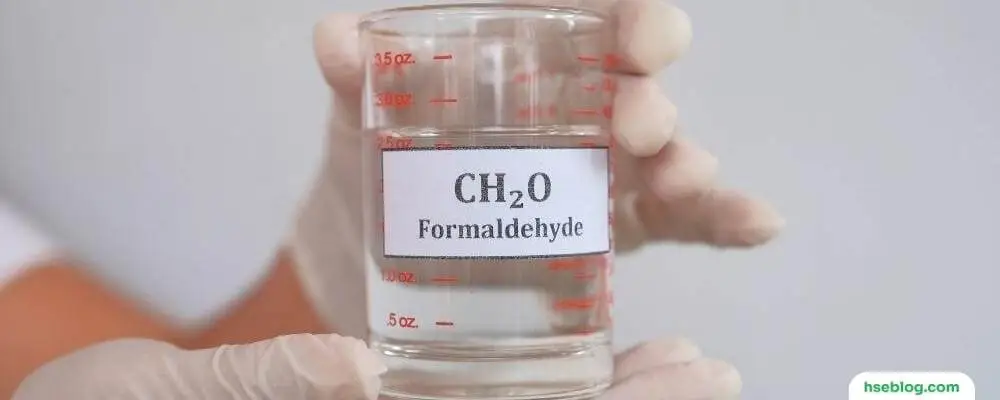Diving into the complex world of chemical substances, we focus on a compound that silently interweaves with our daily lives – formaldehyde. Though it may not be a household name, formaldehyde’s ubiquity is astonishing. In this blog post, we will explore formaldehyde, its wide array of uses, and, most importantly, its potential impacts on the human body. Despite its numerous applications, formaldehyde carries several potential side effects, both short-term and long-term, which we will delve into in detail. Our mission is to help you understand this compound better, empowering you with the knowledge to make informed decisions about its presence in your environment.
What Is Formaldehyde?
Formaldehyde is a chemical compound extensively utilized for its antiseptic and sterilizing properties. In settings like medical labs and funeral homes, it’s often used as a preservative and plays a vital role in creating viral vaccines. In the form of a solid polymer called paraformaldehyde, it can be vaporized using heat, offering a method for decontaminating biological safety cabinets used in laboratories. It’s also frequently combined with water to create a solution known as formalin.
Despite its widespread uses, formaldehyde can pose serious health risks. Healthcare professionals exposed to it may experience harmful effects, including skin irritation, eyes, throat, and lungs. Prolonged or repeated exposure can potentially increase the risk of developing cancer. The severity of these health impacts typically depends on the quantity of exposure, the length of time a person is exposed, and the specific tasks being performed.

Formaldehyde Uses
Formaldehyde is a vital chemical component used in manufacturing numerous everyday products, even though it often leaves little to no trace in the final items. When dissolved in water, this substance is known as formalin, which finds use in various industries, from food preservation to disinfection, and even embalming in funeral homes.
Construction and Building Applications of Formalin:
Formaldehyde-based resins are a key component in creating composite and engineered wood products prevalent in various furnishings and structures, such as cabinets, countertops, moldings, furniture, shelves, stair systems, flooring, wall sheathing, and more. These resins provide robust bonding properties, ensuring durability and cost-effectiveness. They also facilitate the creation of panel and board products, promoting sustainable use of forestry resources by reducing waste and enabling the repurposing of wood waste.
Healthcare Uses of Formalin:
Formaldehyde has an established record of safe use in producing vaccines, anti-infective drugs, and hard-gel capsules. It’s used, for example, in influenza vaccine production, where it helps to neutralize viruses, preventing them from causing disease.
Formalin in Personal Care and Consumer Products:
Formaldehyde-based chemistry is also applied in creating numerous consumer goods and personal care products. Preservatives derived from formaldehyde are employed in these products to eliminate microbes and prevent bacterial growth, thus enhancing their shelf life.
Automobile Applications of Formalin:
Formaldehyde-based technology contributes to making vehicles lighter and more fuel-efficient. The industry utilizes formaldehyde-based polymers to construct interior moldings, high-temperature-resistant components, and various fuel system parts. Additionally, these resins are incorporated in brake pads, clear coat paints, tire-cord adhesives, and durable exterior primers.
Use of Formalin in Photography:
In photography, small quantities of formaldehyde are used as stabilizers in processes like C-41 (color negative film) and E-6 pre-bleach step. It’s particularly used during the final wash stage, making it unnecessary to perform additional washes.

Formaldehyde Side Effects On The Body
Formaldehyde is a colorless, pungent-smelling gas often used in industry and medical science. It can cause various adverse health effects and reactions, varying based on the form of exposure and concentration of formaldehyde involved.
Respiratory System
Inhaling formaldehyde can cause irritation and dryness of the nose and throat, and it may even cause olfactory fatigue, leading to a reduced sense of smell. In workplaces where exposure to significant levels of formaldehyde occurs, such as in the textile industry or places where urea-formaldehyde resin is used, employees have reported discomforting symptoms like constant irritation of mucous membranes, wheezing, excessive thirst, and disturbed sleep.
Some workers have even experienced a decline in small airway function over their work shifts. In high concentrations, formaldehyde exposure can also trigger or worsen asthmatic symptoms and may cause pulmonary edema (fluid accumulation in the lungs), potentially leading to life-threatening conditions.
Skin
Direct contact with formaldehyde can cause both primary irritation and allergic dermatitis. For example, people who use products containing formaldehyde, like nail hardeners, textiles, resins, and certain cleaning products, might experience skin irritation or allergic reactions. Also, repeated exposure to formaldehyde can lead to skin sensitization, which may result in allergic reactions even at low concentrations.
Eyes
Formaldehyde is a potent irritant to the eyes, causing discomfort like conjunctivitis and tearing. It can provoke severe eye irritation in higher concentrations. Workers in industries with regular formaldehyde exposure often report eye irritation, and controlled human exposure studies have found thresholds for these effects.
Nervous System
Prolonged inhalation of formaldehyde may lead to olfactory fatigue and increased thresholds for certain scents. In some instances, it can also cause headaches.
Gastrointestinal Tract and Other Internal Organs
Acute ingestion of formaldehyde can have serious internal effects, including loss of consciousness, vascular collapse, pneumonia, hemorrhagic nephritis (inflammation of the kidneys), and in severe cases, it can lead to fatality.
It’s important to note that these effects are most often observed when individuals are exposed to formaldehyde at significantly higher concentrations than those typically encountered in everyday environments. However, long-term exposure to formaldehyde can lead to chronic health issues even at lower levels. Therefore, managing and minimizing exposure is critical, especially in workplaces where formaldehyde is frequently used.
Conclusion
Navigating through the intricate paths of formaldehyde, we’ve illuminated its nature, practical uses, and potential impacts on the human body. This potent compound, often unrecognizable yet pervasive daily, has beneficial applications and potential risks. An informed understanding of formaldehyde must acknowledge its benefits while mitigating potential health hazards. As we close this exploration, it is crucial to remember the delicate balance that exists with formaldehyde, a testament to humanity’s nuanced relationship with the world of chemistry.

